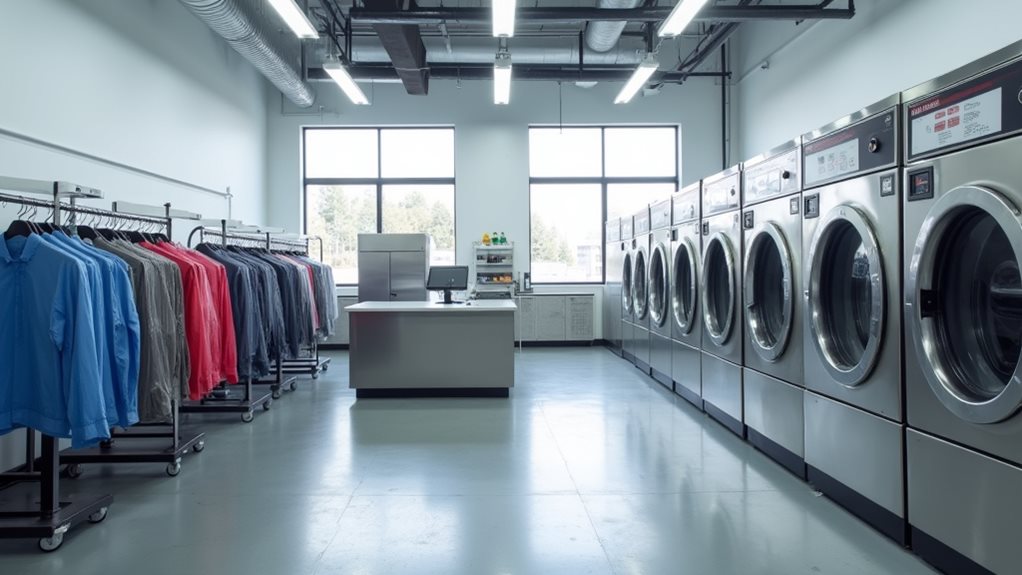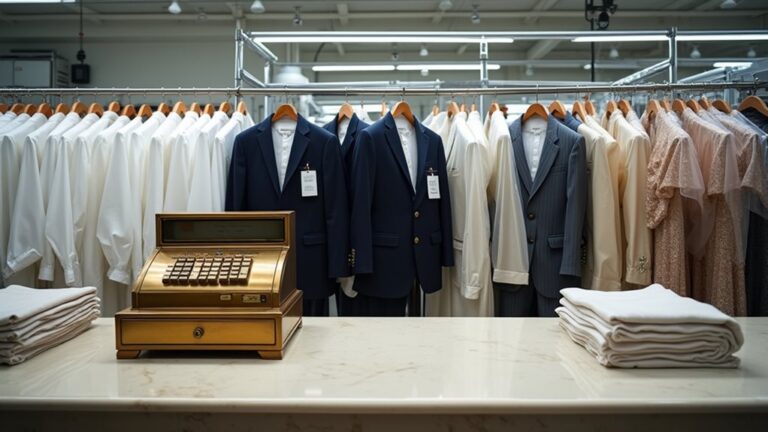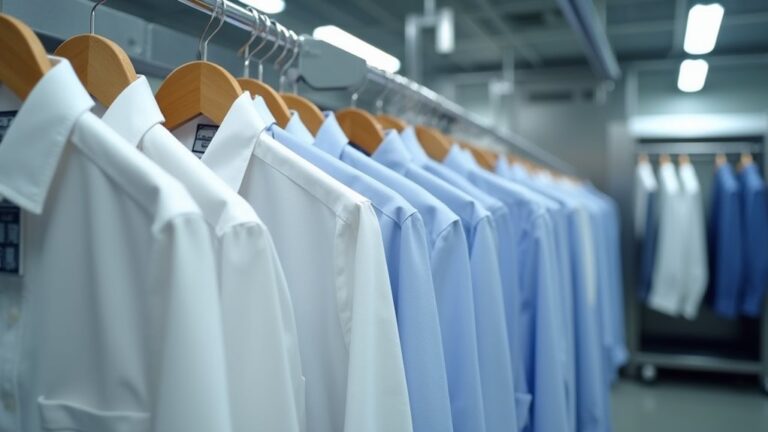You’ll need $90,000 to $550,000 to open a traditional dry cleaning storefront, though I’ve learned from researching countless business models that delivery-focused operations can start for under $50,000. Your biggest expenses include dry cleaning equipment ($15,000-$40,000), monthly property costs ($2,500-$9,000), and initial payroll ($12,000-$25,000 first month). Don’t forget licensing fees, marketing budgets, and that essential emergency fund—because understanding these hidden costs separates dreamers from successful owners.
Understanding Different Dry Cleaning Business Models and Their Financial Requirements
When I first started researching dry cleaning businesses, I honestly thought they were all pretty much the same—you know, those dimly lit storefronts with the mysterious chemical smell and racks of plastic-wrapped clothes.
Boy, was I wrong! Your dry cleaning business model choice completely transforms your startup costs and initial investment strategy. Traditional storefronts demand serious storefront investment, typically $90,000 to $550,000, covering everything from equipment costs to operational expenses and market presence establishment.
However, delivery services offer incredible customer convenience with much lower financial barriers—often under $50,000 for vehicle acquisition and branding.
Delivery services slash startup costs to under $50,000 while maximizing customer convenience—a game-changing approach for new entrepreneurs.
Drop locations present another smart option, expanding your reach without full storefront commitment. Your financial projections will vary dramatically based on which path you choose, so understanding these models upfront saves costly mistakes later.
Additionally, franchise opportunities may require higher upfront fees but provide established business models and ongoing support that can significantly reduce your startup risks.
Equipment and Product Costs for Dry Cleaning Operations
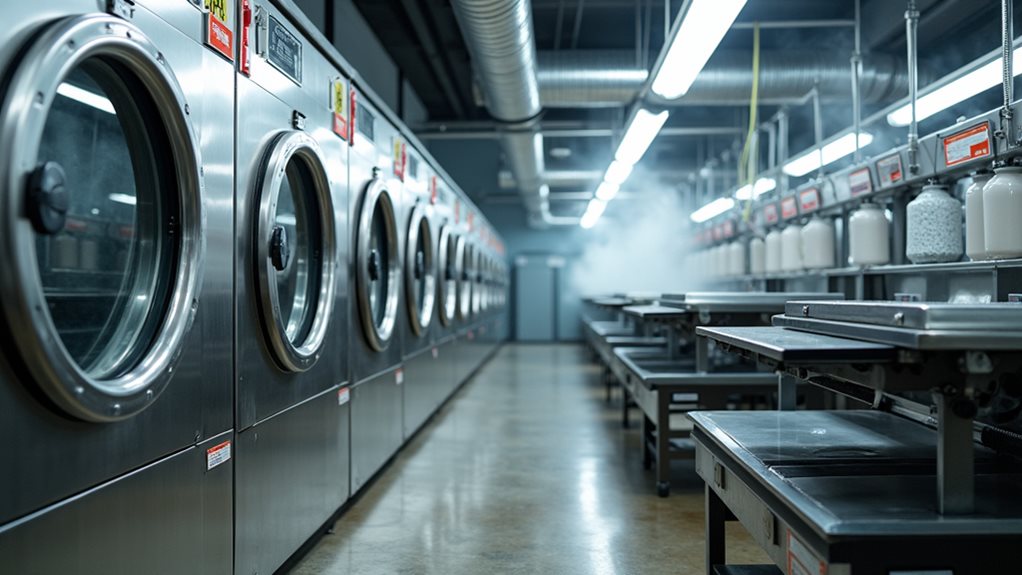
Once you’ve settled on your business model, the reality of equipment costs hits like a freight train—and trust me, I learned this the hard way when I first walked into a commercial equipment showroom expecting “reasonable” prices.
Basic dry cleaning machines will run you $15,000 to $40,000, while high-quality dry cleaning equipment can exceed $70,000.
Don’t forget pressing equipment ($3,000-$8,000), conveyor systems ($1,000-$5,000), and POS systems ($1,000-$3,000) for seamless operations.
Your initial costs also include cleaning supplies, hangers, and tags—adding another $1,500-$3,000 to startup expenses.
Eco-friendly cleaning machines cost $50,000-$100,000 upfront but offer long-term savings and market differentiation that’ll make your competitors jealous 😉.
The entire equipment investment typically falls within the $50,000-$150,000 range for commercial-grade equipment, depending on whether you choose new or used machinery.
Commercial Property Expenses and Location Considerations
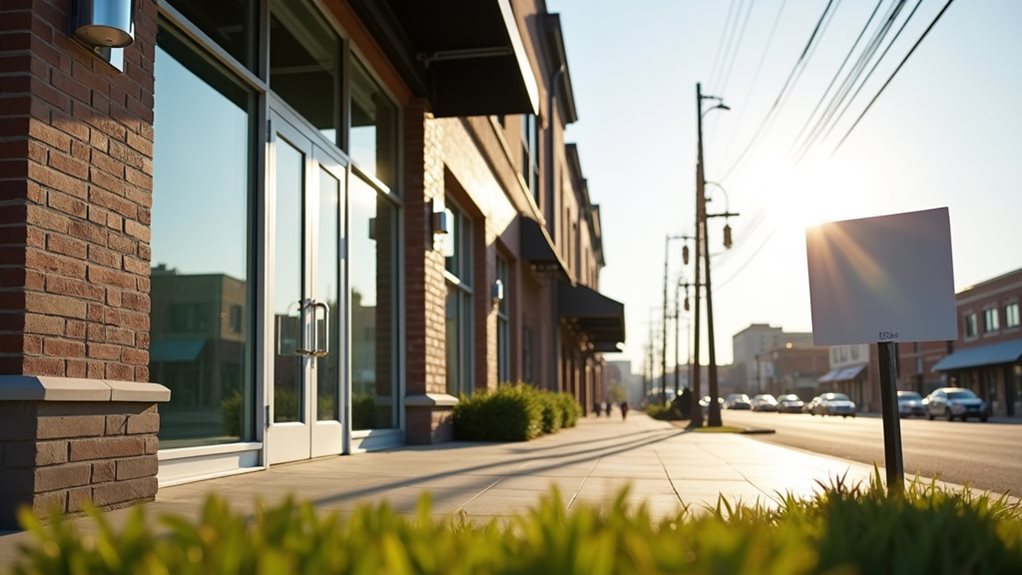
When I first looked at spaces for my friend’s dry cleaning venture, I quickly learned that your monthly property costs will likely become your biggest ongoing expense, ranging from $2,500 to $9,000 depending on where you set up shop and how much square footage you need.
You’ll face the classic entrepreneur’s dilemma of whether to rent (lower upfront costs but no equity building) or buy (potentially $90,000 to $550,000 plus those pesky closing costs that can hit $18,000), and honestly, this decision kept me up more nights than I’d like to admit 😅.
The location you choose will make or break your business because unlike online stores, dry cleaning relies heavily on foot traffic, convenience, and that magical combination of visibility and accessibility that turns casual passersby into loyal customers.
Established businesses in high-traffic areas or affluent neighborhoods tend to perform significantly better due to consistent customer bases and the ability to command premium pricing for their services.
Monthly Property Costs
Since location can make or break your dry cleaning venture, understanding monthly commercial property costs becomes absolutely crucial to your success, and trust me, I learned this lesson the hard way during my first business attempt.
You’ll face monthly commercial property costs ranging from $2,500 to $9,000, depending on your location and space requirements.
Don’t forget those sneaky initial expenses when renting commercial space – security deposits and first month’s rent can easily add several thousand to your startup costs.
Property insurance and utility costs become ongoing monthly expenses that’ll impact your budget considerably, while renovation costs might surprise you if your leased space needs modifications.
These financial considerations demand careful planning before you commit.
In Nigeria’s growing dry cleaning industry, commercial space rental costs typically range from ₦200,000-500,000 annually, with urban locations like Lagos or Abuja commanding premium rates that significantly impact your monthly overhead expenses.
Buying Vs Renting
Although many entrepreneurs rush into property decisions without weighing their options, choosing between buying and renting your dry cleaning space deserves careful consideration because this choice will impact your cash flow for years to come.
Renting commercial property offers flexibility and lower upfront expenses, typically ranging from $2,500 to $9,000 monthly, which I’ve seen help new owners preserve precious startup capital.
However, purchasing stabilizes long-term costs despite higher initial expenses of $90,000 to $550,000, plus closing costs and renovation costs reaching 10-15% of purchase price.
Remember that your chosen location must meet specific ventilation requirements for dry cleaning operations, which may influence both rental rates and renovation expenses regardless of whether you buy or lease the property.
Licensing Requirements and Regulatory Compliance Costs
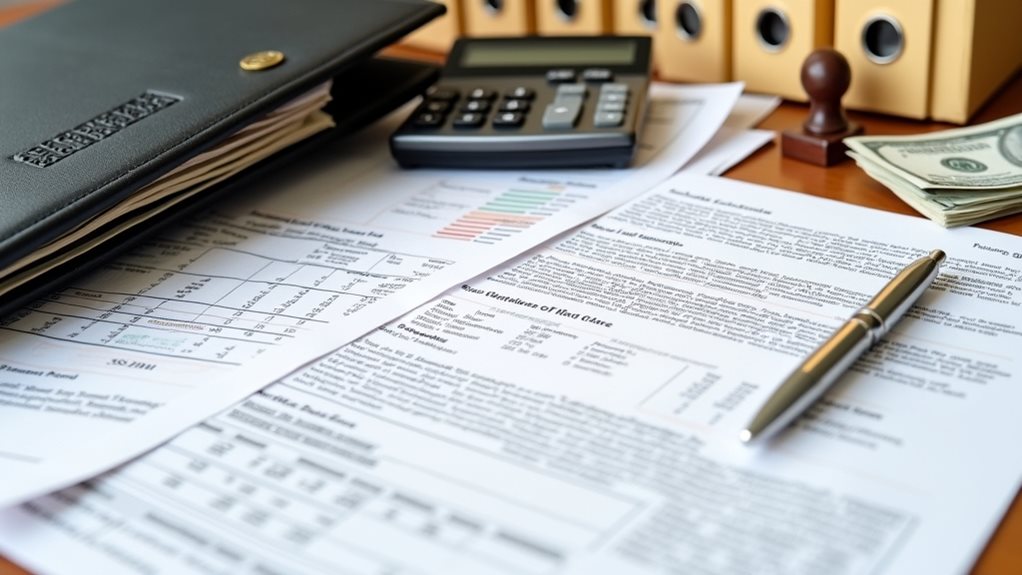
Before diving headfirst into your dry cleaning dreams, you’ll need to steer through the maze of licensing requirements and regulatory compliance costs that can quickly add up to thousands of dollars if you’re not prepared.
Your startup expenses will include permits and licenses ranging from $100 to over $1,000, depending on your location’s quirky regulations. Environmental permits are non-negotiable since you’re dealing with chemicals, potentially costing $500 to several thousand dollars – yeah, it stings a bit!
Health and safety regulations demand inspections and certifications, adding another $200 to $1,500 to your bill. Don’t forget your basic business license ($50-$400), and consider budgeting for legal guidance at $150-$500 per hour because regulatory compliance can feel overwhelming without proper support.
Staffing Budget and Employee Compensation Planning
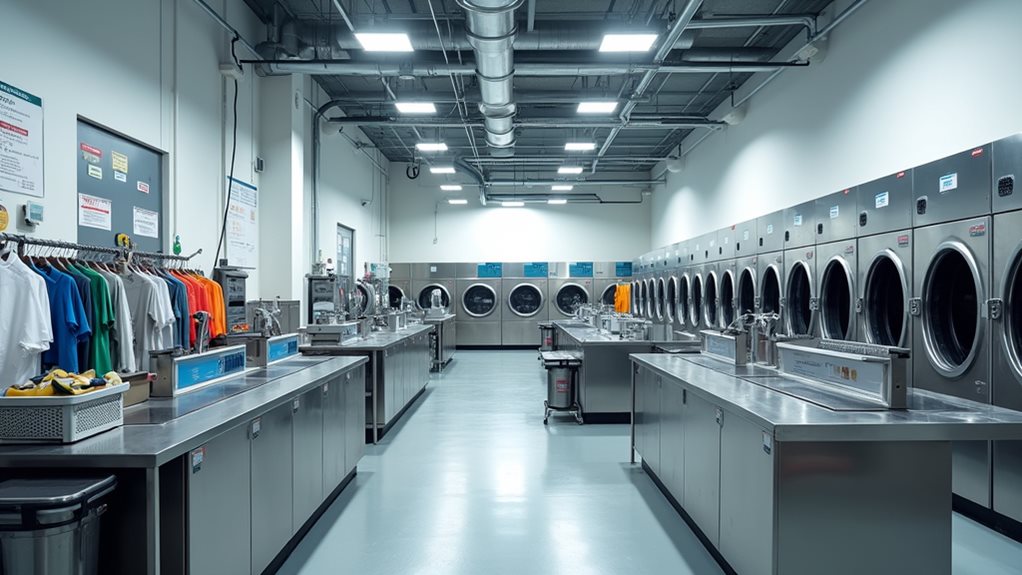
You’ll need to carefully plan your staffing budget since employee compensation typically represents one of your largest monthly expenses, ranging from $12,000 to $25,000 in that vital first month when every dollar counts.
I learned this lesson the hard way when I underestimated payroll costs in my first business venture, watching my carefully calculated budget crumble faster than a poorly pressed shirt 😅.
Understanding important staff roles and creating realistic monthly payroll projections will help you avoid my rookie mistakes, guaranteeing your dry cleaning business maintains healthy cash flow while delivering the quality service your customers expect.
Beyond payroll, you’ll also need to budget for working capital to cover operational expenses during the initial months as you build your customer base.
Essential Staff Roles
When I first opened my dry cleaning shop, I naively thought I could handle everything myself – pressing shirts at dawn, greeting customers with coffee breath, and somehow mastering the art of stain removal by evening 😅.
Reality hit hard when I realized crucial staff roles aren’t optional luxuries. You’ll need skilled dry cleaners who understand fabric chemistry, customer service representatives who can charm even the grumpiest morning clients, and garment handling assistants to manage workflow efficiently.
Employee compensation planning requires offering competitive salaries that attract talent, because training programs take time and investment. Quality service leads to customer satisfaction, but remember that payroll costs will be your largest monthly expense.
Don’t skimp here – good staff makes profitable businesses. Successful operations with quality teams can achieve profit margins between 15-25% annually, making the investment in skilled employees worthwhile.
Monthly Payroll Planning
Monthly payroll planning became my biggest reality check after I confidently hired three people in my first week, only to realize I’d committed to $18,000 in monthly wages without factoring in payroll taxes, workers’ compensation, or the overtime that inevitably comes during busy seasons 🤦♀️.
Your staffing budget should include those crucial positions we discussed, but you’ll need employee payroll projections that account for local wage standards plus an additional 25-30% for payroll taxes and benefits.
I learned to build operational efficiency into my business plan by calculating worst-case scenarios, because trust me, your compensation structure will evolve as you discover which roles actually drive revenue versus which ones just make you feel like a “real business owner.”
Don’t forget to factor in the cost of training employees on handling delicate fabrics and understanding care labels, as this specialized knowledge is essential for providing quality dry cleaning services that keep customers coming back.
Marketing Investment and Brand Development Expenses

Two critical investments will shape your dry cleaning business’s future success: marketing dollars and brand development, which together typically require an initial budget of $10,000 to $20,000 if you’re serious about making a lasting impression in your community.
Your marketing strategy should adopt digital marketing while crafting a memorable brand identity that screams reliability and professionalism.
I’ve learned that customer engagement thrives through strategic partnerships with local businesses—think wedding venues, corporate offices, and boutiques that’ll recommend your services without breaking your advertising expenses.
Smart entrepreneurs allocate 1% to 5% of projected revenue for ongoing marketing efforts, focusing on targeted online campaigns that boost brand visibility.
Successful customer service training for your staff becomes a marketing asset itself, as satisfied customers naturally become your most powerful brand ambassadors through word-of-mouth referrals.
Funding Options and Financial Planning Strategies
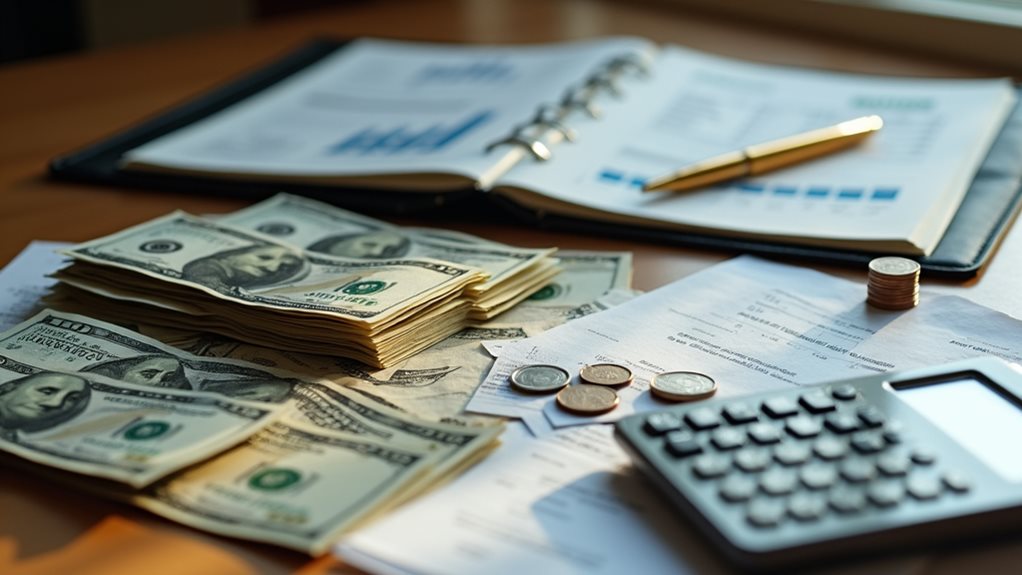
Since securing adequate funding often determines whether your dry cleaning dreams become reality or remain wishful thinking, you’ll need to explore multiple financing avenues while crafting a bulletproof financial plan that’ll impress even the most skeptical bank loan officer.
Your funding options include personal savings, bank loans, crowdfunding platforms, and small business grants averaging $50,000 for eco-conscious initiatives.
That business plan you’re crafting? It’s your golden ticket, requiring detailed financial planning, market analysis, and investment projections.
Allocate 20-25% of initial funding for operating expenses to maintain healthy cash flow during those nerve-wracking early months.
Here’s my hard-learned advice: establish an emergency fund covering 3-6 months of operating expenses ($15,000-$75,000) – trust me, unexpected hiccups happen more often than you’d think! 😅
Understanding that most dry cleaning operations achieve profit margins between 15% to 25% will help you set realistic revenue expectations and determine your break-even point more accurately.

